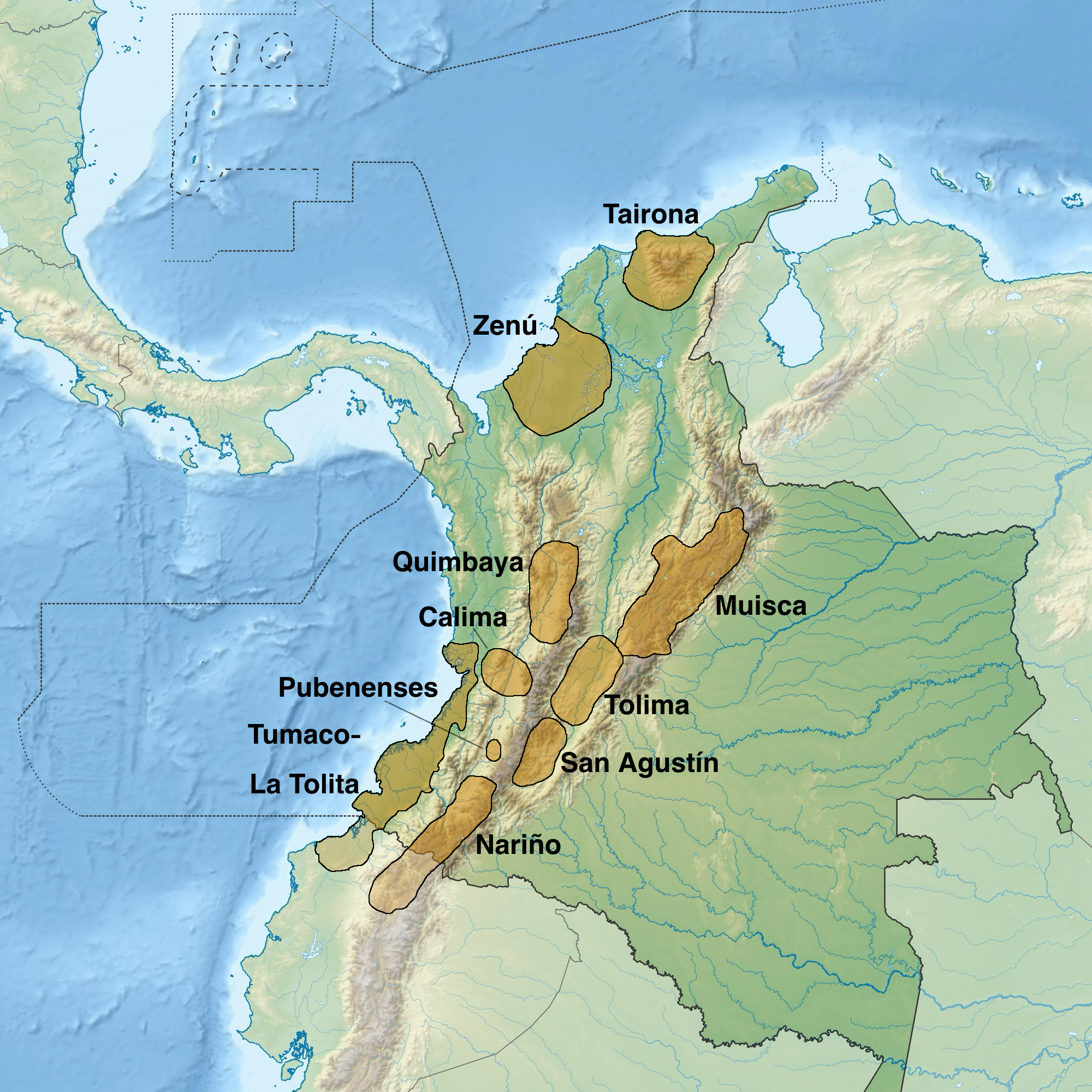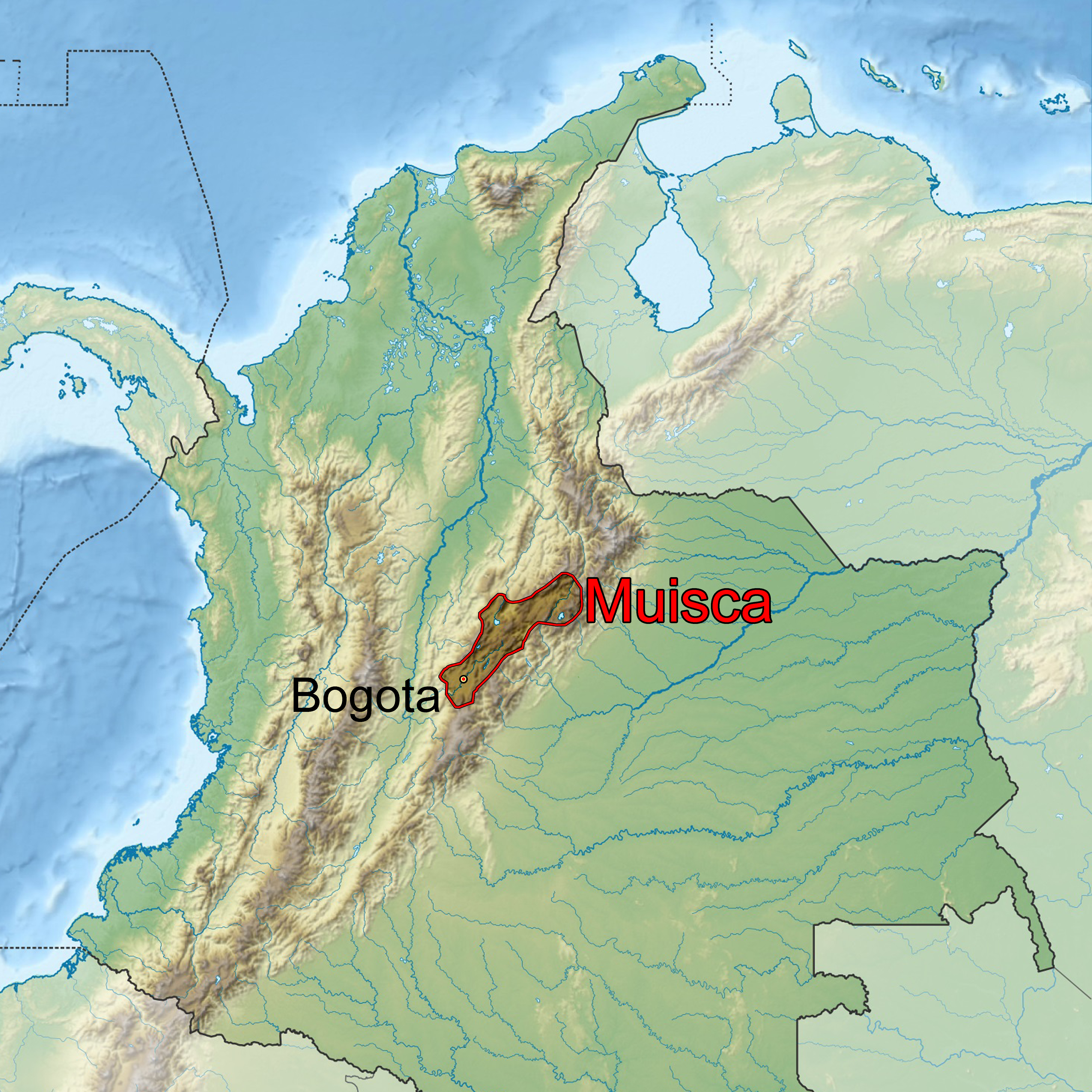|
Tairona
Tairona or Tayrona was a Pre-Columbian cultures of Colombia, Pre-Columbian culture of Colombia, which consisted in a group of chiefdoms in the region of Sierra Nevada de Santa Marta in present-day Cesar Department, Cesar, Magdalena Department, Magdalena and Guajira Department, La Guajira Departments of Colombia, South America, which goes back at least to the 1st century AD and had significant demographic growth around the 11th century. The Tairona people formed one of the two principal linguistic groups of the Chibchan family, the other being the Muisca people, Muisca. Genetic and archaeological evidence shows a relatively dense occupation of the region by at least 200 BC. Pollen data compiled by Luisa Fernanda Herrera in 1980 shows considerable deforestation and the use of cultigens such as yuca and maize since possibly 1200 BC. However, occupation of the Colombian Caribbean coast by sedentary or semi-sedentary populations has been documented to have occurred by c. 4000 BC. Et ... [...More Info...] [...Related Items...] OR: [Wikipedia] [Google] [Baidu] |
Kogi People
The Kogi ( ), or Cogui, or Kágaba, meaning "jaguar" in the Kogi language, are an Indigenous group that resides in the Sierra Nevada de Santa Marta mountains in northern Colombia. Their culture has continued since the Pre-Columbian era. Language The Kogi language belongs to the Chibchan languages, Chibchan family. History The Kogi people are descendants of the Tairona culture, which flourished before the times of the Spanish conquest. The Tairona were an advanced civilization which built many stone structures and pathways in the jungles. They made many gold objects which they would hang from trees and around their necks. They lived similarly to modern-day Kogi. Before the Spanish conquistadors arrived, the Tairona were forced to move into the highlands when the Kalina people, Caribs invaded around 1000 CE. Their new area proved strategic when the Spanish entered in the 15th century. Later, missionary, missionaries came and also began to influence their way of life, building ch ... [...More Info...] [...Related Items...] OR: [Wikipedia] [Google] [Baidu] |
Arhuacos
The Arhuaco are an Indigenous people of Colombia. They are Chibchan-speaking people and descendants of the Tairona culture, concentrated in northern Colombia in the Sierra Nevada de Santa Marta. Name The Arhuaco are also known as the Aruaco, Bintucua, Bintuk, Bíntukua, Ica, Ijca, Ijka, Ika, and Ike people. Territory The Arhuacos live in the upper valleys of the Piedras River, San Sebastian River, Chichicua River, Ariguani River, and Guatapuri River, in an Indigenous territory in the Sierra Nevada de Santa Marta Mountains. Their traditional territory before the Spanish colonization was larger than today's boundaries which exclude many of their sacred sites that they continue to visit today, to pay offerings. These lost territories are the lower parts by the steps of the mountains, lost to colonization and farming. Communities The Arhuacos are distributed into 22 sections. *Central Zone: Nabusimake (Capital of the Arhuaco nation), Yechikin and Busin. *Western Zone: ... [...More Info...] [...Related Items...] OR: [Wikipedia] [Google] [Baidu] |
Sierra Nevada De Santa Marta
The Sierra Nevada de Santa Marta (English: ''Snow-Covered Mountain Range of Saint Martha'') is an isolated mountain range in northern Colombia, separate from the Andes range that runs through the north of the country. Reaching an elevation of just from the Caribbean coast, the Sierra Nevada is the highest coastal range in the tropics, and one of the highest coastal ranges in the world, being shorter than the Saint Elias Mountains in Canada. The Sierra Nevada encompasses about and serves as the source of 36 rivers. The range is in the Departments of Magdalena, Cesar and La Guajira. The highest point of the Sierra Nevada group (and Colombia in general) may be either Pico Cristóbal Colón or Pico Simón Bolívar, both in the municipalities of Santa Marta and Aracataca; it has yet to be determined which is higher. SRTM data and local topographic maps show that their true elevations are approximately , lower than the elevation that is often quoted. The Sierra Nevada i ... [...More Info...] [...Related Items...] OR: [Wikipedia] [Google] [Baidu] |
Pre-Columbian Cultures Of Colombia
The pre-Columbian cultures of Colombia refers to the ancient cultures and civilizations of Colombia. Population The population of pre-Columbian cultures in the modern-day country of Colombia is estimated to have been around 6 million. Around a third of them, or about 2 million people were Muiscas located in Andean highlands, with the population being concentrated in a similar way to modern-day Colombia. Lower estimates number the pre-Columbian population at just around 3 million people whereas higher estimates place the population at 10-12 million people. Geography Owing to its location, the present territory of Colombia was a corridor of early human migration from Mesoamerica and the Caribbean to the Andes and Amazon basin. The oldest archaeological finds are from the Pubenza and El Totumo sites in the Magdalena Valley southwest of Bogotá. These sites date from the Paleoindian period (18,000–8000 BCE). At Puerto Hormiga and other sites, traces from the Archaic Perio ... [...More Info...] [...Related Items...] OR: [Wikipedia] [Google] [Baidu] |
Chibchan
The Chibchan languages (also known as Chibchano) make up a language family indigenous to the Isthmo-Colombian Area, which extends from eastern Honduras to northern Colombia and includes populations of these countries as well as Nicaragua, Costa Rica, and Panama. The name is derived from the name of an extinct language called ''Chibcha'' or ''Muisca'', once spoken by the people who lived on the Altiplano Cundiboyacense of which the city of Bogotá was the southern capital at the time of the Spanish Conquista. However, genetic and linguistic data now indicate that the original heart of Chibchan languages and Chibchan-speaking peoples might not have been in Colombia, but in the area of the Costa Rica-Panama border, where the greatest variety of Chibchan languages has been identified. External relations A larger family called '' Macro-Chibchan'', which would contain the Misumalpan languages, Xinca, and Lenca, was found convincing by Kaufman (1990). Based primarily on evidence from ... [...More Info...] [...Related Items...] OR: [Wikipedia] [Google] [Baidu] |
Wiwa People
The Wiwa people, also known as the Damana people, are an Indigenous peoples of the Americas, Indigenous people of Colombia that speak the Chibchan languages, Chibchan Wiwa language, Dʉmʉna language and live in the Sierra Nevada de Santa Marta region. Etymology The word ''Wiwa'' comes from the Dʉmʉna language, ''wi'' meaning warm or warm area and ''wa'' meaning people, combined to mean people of warm land. This refers to the Wiwa's historic inhabitance in the lower, warmer parts of the Sierra Nevada mountains. The Wiwa are also known as the ''Sajas'', which means Native or Indigenous, as opposed to ''Sintalu,'' meaning foreign, non-Indigenous. The origin of the demonym ''Malayos'' is unclear, but it is also used. Other regional demonyms typical of Wiwa villages are: ''guamacas'' (from Guamaka), ''marocaseros'' (from Marokaso), and ''arsarios'' (from El Rosario). History The Wiwa are direct descendants of the Tairona, Tairona people. Territory The Wiwa's historical terr ... [...More Info...] [...Related Items...] OR: [Wikipedia] [Google] [Baidu] |
Colombia
Colombia, officially the Republic of Colombia, is a country primarily located in South America with Insular region of Colombia, insular regions in North America. The Colombian mainland is bordered by the Caribbean Sea to the north, Venezuela to the east and northeast, Brazil to the southeast, Peru and Ecuador to the south and southwest, the Pacific Ocean to the west, and Panama to the northwest. Colombia is divided into 32 Departments of Colombia, departments. The Capital District of Bogotá is also the List of cities in Colombia by population, country's largest city hosting the main financial and cultural hub. Other major urban areas include Medellín, Cali, Barranquilla, Cartagena, Colombia, Cartagena, Santa Marta, Cúcuta, Ibagué, Villavicencio and Bucaramanga. It covers an area of 1,141,748 square kilometers (440,831 sq mi) and has a population of around 52 million. Its rich cultural heritage—including language, religion, cuisine, and art—reflects its history as a co ... [...More Info...] [...Related Items...] OR: [Wikipedia] [Google] [Baidu] |
Muisca People
The Muisca (also called the Chibcha) are indigenous peoples in Colombia and were a Pre-Columbian culture of the Altiplano Cundiboyacense that formed the Muisca Confederation before the Spanish colonization of the Americas. The Muisca speak Muysccubun, a language of the Chibchan language family, also called ''Muysca'' and ''Mosca''. The first known contact with Europeans in the region was in 1537 during the Spanish conquest of New Granada. In New Spain, Spanish clerics and civil officials had a major impact on the Muisca, attempting to Christianize and incorporate them into the Spanish Empire as subjects. Postconquest Muisca culture underwent significant changes due to the establishment of the New Kingdom of Granada. Sources for the Muisca are far less abundant than for the Aztec Empire of Mesoamerica or the Inca Empire and their incorporation to the Spanish Empire during the colonial era. In the New Kingdom of Granada and into the colonial era, the Muisca became " ... [...More Info...] [...Related Items...] OR: [Wikipedia] [Google] [Baidu] |
Carbon-14 Dating
Radiocarbon dating (also referred to as carbon dating or carbon-14 dating) is a method for Chronological dating, determining the age of an object containing organic material by using the properties of carbon-14, radiocarbon, a radioactive Isotopes of carbon, isotope of carbon. The method was developed in the late 1940s at the University of Chicago by Willard Libby. It is based on the fact that radiocarbon () is constantly being created in the Atmosphere of Earth, Earth's atmosphere by the interaction of cosmic rays with atmospheric nitrogen. The resulting combines with atmospheric oxygen to form radioactive carbon dioxide, which is incorporated into plants by photosynthesis; animals then acquire by eating the plants. When the animal or plant dies, it stops exchanging carbon with its environment, and thereafter the amount of it contains begins to decrease as the undergoes radioactive decay. Measuring the amount of in a sample from a dead plant or animal, such as a piece of w ... [...More Info...] [...Related Items...] OR: [Wikipedia] [Google] [Baidu] |
Elevation
The elevation of a geographic location (geography), ''location'' is its height above or below a fixed reference point, most commonly a reference geoid, a mathematical model of the Earth's sea level as an equipotential gravitational equipotential surface, surface (see Geodetic datum#Vertical datum, Geodetic datum § Vertical datum). The term ''elevation'' is mainly used when referring to points on the Earth's surface, while ''altitude'' or ''geopotential height'' is used for points above the surface, such as an aircraft in flight or a spacecraft in orbit, and ''three-dimensional space, depth'' is used for points below the surface. Elevation is not to be confused with the distance from the center of the Earth. Due to the equatorial bulge, the summits of Mount Everest and Chimborazo (volcano), Chimborazo have, respectively, the largest elevation and the largest ECEF, geocentric distance. Aviation In aviation, the term ''elevation'' or ''aerodrome elevation'' is defined by the IC ... [...More Info...] [...Related Items...] OR: [Wikipedia] [Google] [Baidu] |






